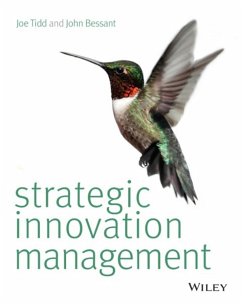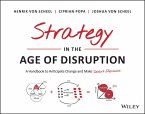Joe Tidd (The Management School, Imperial College of Science, Techn, John R. Bessant (University of Brighton)
Strategic Innovation Management
Joe Tidd (The Management School, Imperial College of Science, Techn, John R. Bessant (University of Brighton)
Strategic Innovation Management
- Broschiertes Buch
- Merkliste
- Auf die Merkliste
- Bewerten Bewerten
- Teilen
- Produkt teilen
- Produkterinnerung
- Produkterinnerung
This first edition of Strategic Innovation Management is an exciting new addition to the established bestselling texts Managing Innovation and Innovation and Entrepreneurship written by Joe Tidd and John Bessant.
Andere Kunden interessierten sich auch für
![Corporate Explorer Corporate Explorer]() Andrew Binns (Change Logic)Corporate Explorer19,99 €
Andrew Binns (Change Logic)Corporate Explorer19,99 €![Seeding Innovation Seeding Innovation]() Robyn O'Brien (Rice University)Seeding Innovation22,99 €
Robyn O'Brien (Rice University)Seeding Innovation22,99 €![Strategy in the Age of Disruption Strategy in the Age of Disruption]() Henrik Von ScheelStrategy in the Age of Disruption27,99 €
Henrik Von ScheelStrategy in the Age of Disruption27,99 €![Suddenly Hybrid Suddenly Hybrid]() Karin M. ReedSuddenly Hybrid30,99 €
Karin M. ReedSuddenly Hybrid30,99 €![The Authentic Organization The Authentic Organization]() Gina BattyeThe Authentic Organization32,99 €
Gina BattyeThe Authentic Organization32,99 €![The Fast Future Blur The Fast Future Blur]() The Fast Future ExecutiveThe Fast Future Blur47,99 €
The Fast Future ExecutiveThe Fast Future Blur47,99 €![The E Factor The E Factor]() David GibsonThe E Factor26,99 €
David GibsonThe E Factor26,99 €-
-
-
This first edition of Strategic Innovation Management is an exciting new addition to the established bestselling texts Managing Innovation and Innovation and Entrepreneurship written by Joe Tidd and John Bessant.
Hinweis: Dieser Artikel kann nur an eine deutsche Lieferadresse ausgeliefert werden.
Hinweis: Dieser Artikel kann nur an eine deutsche Lieferadresse ausgeliefert werden.
Produktdetails
- Produktdetails
- Verlag: John Wiley & Sons Inc
- Seitenzahl: 448
- Erscheinungstermin: 28. März 2014
- Englisch
- Abmessung: 233mm x 184mm x 22mm
- Gewicht: 914g
- ISBN-13: 9781118457238
- ISBN-10: 1118457234
- Artikelnr.: 42638864
- Herstellerkennzeichnung
- Libri GmbH
- Europaallee 1
- 36244 Bad Hersfeld
- gpsr@libri.de
- Verlag: John Wiley & Sons Inc
- Seitenzahl: 448
- Erscheinungstermin: 28. März 2014
- Englisch
- Abmessung: 233mm x 184mm x 22mm
- Gewicht: 914g
- ISBN-13: 9781118457238
- ISBN-10: 1118457234
- Artikelnr.: 42638864
- Herstellerkennzeichnung
- Libri GmbH
- Europaallee 1
- 36244 Bad Hersfeld
- gpsr@libri.de
Joe Tidd is Professor of Technology and Innovation Management at SPRU (Science and Technology Policy Research), University of Sussex, UK and visiting Professor at University College London. John Bessant holds the Chair in Innovation and Entrepreneurship at Exeter University where he is also Research Director.
About the Authors xi
Preface xiii
Acknowledgements xv
How to Use This Book xvii
Part I Foundations of Managing Innovation 1
Chapter 1 What Is Innovation - And Why Does It Matter? 3
What Is Innovation? 3
Why Does Innovation Matter? 9
To Whom? 10
Innovation Isn't Easy! 10
Can We Manage Innovation? 12
The Case for Strategic Innovation Management 13
Summary 16
Further Resources 16
References 17
Chapter 2 Innovation Strategy 21
Why Strategy? 21
What's in an Innovation Strategy? 22
Strategy at Different Levels 33
Dynamic Capability 35
Summary 37
Further Resources 37
References 38
Chapter 3 Identifying Strategic Capabilities 41
The Resource-Based View 41
Distinguishing Capabilities from Resources 42
Assessing Capabilities 46
Creating and Capturing Value 53
Beware of Core Rigidities 55
Summary 57
Further Resources 57
References 57
Chapter 4 Leadership and Organization of Innovation 61
The Innovative Organization 61
Innovation Leadership 62
Collective and Social 65
Context and Climate 72
Summary 76
Further Resources 76
References 77
Chapter 5 Innovation as a Process 81
Beyond Spengler 81
A Map of the Process 82
Managing the Process 86
Learning to Manage Innovation 90
The Problem of Partial Models 91
Summary 94
Further Resources 94
References 96
Chapter 6 Sources of Innovation 97
Where Do Innovations Come From? 97
Knowledge Push 98
Need Pull. . . 99
Making Processes Better 101
Whose Needs? Working at the Edge 103
Crisis Driven Innovation 105
Towards Mass Customization 107
Users as Innovators 107
Watching Others - and Learning from Them 110
Recombinant Innovation 111
Regulation 111
Futures and Forecasting 112
Design-driven Innovation 113
Accidents 114
Summary 116
Further Resources 116
References 117
Chapter 7 Search Strategies for Innovation 119
Making Sense of the Sources 119
The Innovation Treasure Hunt 122
Innovation Search Strategies 127
Strategies for Searching 131
Innovation Networks 133
Knowledge Management 134
Learning to Search 135
Summary 137
Further Resources 137
References 138
Chapter 8 Forecasting Emerging Opportunities for Innovation 141
Forecasting 141
Customer or Market Surveys 143
Internal: Brainstorming 144
External: Benchmarking 145
Scenario Development 149
Summary 156
Further Resources 156
References 157
Chapter 9 Selecting Innovation Projects 159
Why is Selection a Challenge? 159
Choosing between Projects 162
Summary 178
Further Resources 178
References 179
Chapter 10 Developing New Products and Services 181
The New Product/Service Development Process 181
Success Factors 186
Service Development 188
Tools to Support New Product Development 193
Summary 199
Further Resources 199
References 200
Chapter 11 Developing Business and Talent through Corporate Venturing 203
Internal Venturing and Entrepreneurship 203
Why Do It? 205
Managing Corporate Ventures 211
Strategic Impact of Ventures 219
Summary 220
Further Resources 220
References 220
Chapter 12 Commercialization and Diffusion of Innovations 223
Why Adopt Innovations? 223
Models of Diffusion 227
Factors Influencing Adoption 230
Applying Diffusion to Innovation Strategy 237
Summary 240
Further Resources 240
References 240
Chapter 13 Exploiting Knowledge and Intellectual Property 243
Innovation and Knowledge 243
Summary 260
Further Resources 260
References 261
Chapter 14 Business Models and Capturing Value 263
What's a Business Model? 263
Generic and Specific Business Models 267
Why Use Business Models? 268
Building a Business Model 269
Business Model Innovation 273
Summary 275
Further Resources 275
References 275
Chapter 15 Capture Value: Learning to Manage Innovation 277
The Story So Far . . . 277
Making Innovation Happen 278
Learning in Organizations 280
Innovation Auditing 281
Innovation Auditing in Practice 288
Dynamic Capability and Changing Our Routines 291
Summary 292
Further Resources 292
References 293
Part II The Innovation Frontier 295
Chapter 16 Users as Innovators 297
Users Aren't Passive 297
Lead Users 300
Extreme Users 303
Co-development 304
Democratic Innovation and Crowdsourcing 305
Summary 308
Further Resources 308
References 309
Chapter 17 Exploiting Open Innovation and Strategic Alliances 311
Open Innovation 311
Benefits and Limits of Open Innovation 315
Joint Ventures and Strategic Alliances 323
Summary 326
Further Resources 326
References 326
Chapter 18 Exploiting Discontinuous Innovation 331
Beyond the Steady State 332
The Problem - and the Opportunity - in Discontinuous Innovation 333
Innovation Lifecycles: From Discontinuity to Steady State 335
Discontinuous Can Be Disruptive 337
Managing Discontinuous Innovation 343
Dealing with Discontinuity 344
Summary 347
Further Resources 347
References 348
Chapter 19 Social Innovation 351
What Is 'Social Innovation'? 352
Definitions and Exploration of the Core Idea 355
The Challenge of Social Entrepreneurship 358
Enabling Social Innovation 359
Why Social Innovation? 361
Summary 367
Further Resources 367
References 368
Chapter 20 Innovation in Developing and Emerging Economies 371
Globalization and Innovation 371
Looking Back 373
Building BRICs: The Rise of New Players on the Innovation Stage 374
Developing Countries 383
Summary 387
Further Resources 387
References 388
Chapter 21 Sustainability 389
The Challenge of Sustainability-led Innovation 389
We've Seen This Before 391
Sustainability-led Innovation 392
Managing the Innovation Process for Sustainability 399
Responsible Innovation 402
Summary 404
Further Resources 404
References 405
Index 409
Preface xiii
Acknowledgements xv
How to Use This Book xvii
Part I Foundations of Managing Innovation 1
Chapter 1 What Is Innovation - And Why Does It Matter? 3
What Is Innovation? 3
Why Does Innovation Matter? 9
To Whom? 10
Innovation Isn't Easy! 10
Can We Manage Innovation? 12
The Case for Strategic Innovation Management 13
Summary 16
Further Resources 16
References 17
Chapter 2 Innovation Strategy 21
Why Strategy? 21
What's in an Innovation Strategy? 22
Strategy at Different Levels 33
Dynamic Capability 35
Summary 37
Further Resources 37
References 38
Chapter 3 Identifying Strategic Capabilities 41
The Resource-Based View 41
Distinguishing Capabilities from Resources 42
Assessing Capabilities 46
Creating and Capturing Value 53
Beware of Core Rigidities 55
Summary 57
Further Resources 57
References 57
Chapter 4 Leadership and Organization of Innovation 61
The Innovative Organization 61
Innovation Leadership 62
Collective and Social 65
Context and Climate 72
Summary 76
Further Resources 76
References 77
Chapter 5 Innovation as a Process 81
Beyond Spengler 81
A Map of the Process 82
Managing the Process 86
Learning to Manage Innovation 90
The Problem of Partial Models 91
Summary 94
Further Resources 94
References 96
Chapter 6 Sources of Innovation 97
Where Do Innovations Come From? 97
Knowledge Push 98
Need Pull. . . 99
Making Processes Better 101
Whose Needs? Working at the Edge 103
Crisis Driven Innovation 105
Towards Mass Customization 107
Users as Innovators 107
Watching Others - and Learning from Them 110
Recombinant Innovation 111
Regulation 111
Futures and Forecasting 112
Design-driven Innovation 113
Accidents 114
Summary 116
Further Resources 116
References 117
Chapter 7 Search Strategies for Innovation 119
Making Sense of the Sources 119
The Innovation Treasure Hunt 122
Innovation Search Strategies 127
Strategies for Searching 131
Innovation Networks 133
Knowledge Management 134
Learning to Search 135
Summary 137
Further Resources 137
References 138
Chapter 8 Forecasting Emerging Opportunities for Innovation 141
Forecasting 141
Customer or Market Surveys 143
Internal: Brainstorming 144
External: Benchmarking 145
Scenario Development 149
Summary 156
Further Resources 156
References 157
Chapter 9 Selecting Innovation Projects 159
Why is Selection a Challenge? 159
Choosing between Projects 162
Summary 178
Further Resources 178
References 179
Chapter 10 Developing New Products and Services 181
The New Product/Service Development Process 181
Success Factors 186
Service Development 188
Tools to Support New Product Development 193
Summary 199
Further Resources 199
References 200
Chapter 11 Developing Business and Talent through Corporate Venturing 203
Internal Venturing and Entrepreneurship 203
Why Do It? 205
Managing Corporate Ventures 211
Strategic Impact of Ventures 219
Summary 220
Further Resources 220
References 220
Chapter 12 Commercialization and Diffusion of Innovations 223
Why Adopt Innovations? 223
Models of Diffusion 227
Factors Influencing Adoption 230
Applying Diffusion to Innovation Strategy 237
Summary 240
Further Resources 240
References 240
Chapter 13 Exploiting Knowledge and Intellectual Property 243
Innovation and Knowledge 243
Summary 260
Further Resources 260
References 261
Chapter 14 Business Models and Capturing Value 263
What's a Business Model? 263
Generic and Specific Business Models 267
Why Use Business Models? 268
Building a Business Model 269
Business Model Innovation 273
Summary 275
Further Resources 275
References 275
Chapter 15 Capture Value: Learning to Manage Innovation 277
The Story So Far . . . 277
Making Innovation Happen 278
Learning in Organizations 280
Innovation Auditing 281
Innovation Auditing in Practice 288
Dynamic Capability and Changing Our Routines 291
Summary 292
Further Resources 292
References 293
Part II The Innovation Frontier 295
Chapter 16 Users as Innovators 297
Users Aren't Passive 297
Lead Users 300
Extreme Users 303
Co-development 304
Democratic Innovation and Crowdsourcing 305
Summary 308
Further Resources 308
References 309
Chapter 17 Exploiting Open Innovation and Strategic Alliances 311
Open Innovation 311
Benefits and Limits of Open Innovation 315
Joint Ventures and Strategic Alliances 323
Summary 326
Further Resources 326
References 326
Chapter 18 Exploiting Discontinuous Innovation 331
Beyond the Steady State 332
The Problem - and the Opportunity - in Discontinuous Innovation 333
Innovation Lifecycles: From Discontinuity to Steady State 335
Discontinuous Can Be Disruptive 337
Managing Discontinuous Innovation 343
Dealing with Discontinuity 344
Summary 347
Further Resources 347
References 348
Chapter 19 Social Innovation 351
What Is 'Social Innovation'? 352
Definitions and Exploration of the Core Idea 355
The Challenge of Social Entrepreneurship 358
Enabling Social Innovation 359
Why Social Innovation? 361
Summary 367
Further Resources 367
References 368
Chapter 20 Innovation in Developing and Emerging Economies 371
Globalization and Innovation 371
Looking Back 373
Building BRICs: The Rise of New Players on the Innovation Stage 374
Developing Countries 383
Summary 387
Further Resources 387
References 388
Chapter 21 Sustainability 389
The Challenge of Sustainability-led Innovation 389
We've Seen This Before 391
Sustainability-led Innovation 392
Managing the Innovation Process for Sustainability 399
Responsible Innovation 402
Summary 404
Further Resources 404
References 405
Index 409
About the Authors xi
Preface xiii
Acknowledgements xv
How to Use This Book xvii
Part I Foundations of Managing Innovation 1
Chapter 1 What Is Innovation - And Why Does It Matter? 3
What Is Innovation? 3
Why Does Innovation Matter? 9
To Whom? 10
Innovation Isn't Easy! 10
Can We Manage Innovation? 12
The Case for Strategic Innovation Management 13
Summary 16
Further Resources 16
References 17
Chapter 2 Innovation Strategy 21
Why Strategy? 21
What's in an Innovation Strategy? 22
Strategy at Different Levels 33
Dynamic Capability 35
Summary 37
Further Resources 37
References 38
Chapter 3 Identifying Strategic Capabilities 41
The Resource-Based View 41
Distinguishing Capabilities from Resources 42
Assessing Capabilities 46
Creating and Capturing Value 53
Beware of Core Rigidities 55
Summary 57
Further Resources 57
References 57
Chapter 4 Leadership and Organization of Innovation 61
The Innovative Organization 61
Innovation Leadership 62
Collective and Social 65
Context and Climate 72
Summary 76
Further Resources 76
References 77
Chapter 5 Innovation as a Process 81
Beyond Spengler 81
A Map of the Process 82
Managing the Process 86
Learning to Manage Innovation 90
The Problem of Partial Models 91
Summary 94
Further Resources 94
References 96
Chapter 6 Sources of Innovation 97
Where Do Innovations Come From? 97
Knowledge Push 98
Need Pull. . . 99
Making Processes Better 101
Whose Needs? Working at the Edge 103
Crisis Driven Innovation 105
Towards Mass Customization 107
Users as Innovators 107
Watching Others - and Learning from Them 110
Recombinant Innovation 111
Regulation 111
Futures and Forecasting 112
Design-driven Innovation 113
Accidents 114
Summary 116
Further Resources 116
References 117
Chapter 7 Search Strategies for Innovation 119
Making Sense of the Sources 119
The Innovation Treasure Hunt 122
Innovation Search Strategies 127
Strategies for Searching 131
Innovation Networks 133
Knowledge Management 134
Learning to Search 135
Summary 137
Further Resources 137
References 138
Chapter 8 Forecasting Emerging Opportunities for Innovation 141
Forecasting 141
Customer or Market Surveys 143
Internal: Brainstorming 144
External: Benchmarking 145
Scenario Development 149
Summary 156
Further Resources 156
References 157
Chapter 9 Selecting Innovation Projects 159
Why is Selection a Challenge? 159
Choosing between Projects 162
Summary 178
Further Resources 178
References 179
Chapter 10 Developing New Products and Services 181
The New Product/Service Development Process 181
Success Factors 186
Service Development 188
Tools to Support New Product Development 193
Summary 199
Further Resources 199
References 200
Chapter 11 Developing Business and Talent through Corporate Venturing 203
Internal Venturing and Entrepreneurship 203
Why Do It? 205
Managing Corporate Ventures 211
Strategic Impact of Ventures 219
Summary 220
Further Resources 220
References 220
Chapter 12 Commercialization and Diffusion of Innovations 223
Why Adopt Innovations? 223
Models of Diffusion 227
Factors Influencing Adoption 230
Applying Diffusion to Innovation Strategy 237
Summary 240
Further Resources 240
References 240
Chapter 13 Exploiting Knowledge and Intellectual Property 243
Innovation and Knowledge 243
Summary 260
Further Resources 260
References 261
Chapter 14 Business Models and Capturing Value 263
What's a Business Model? 263
Generic and Specific Business Models 267
Why Use Business Models? 268
Building a Business Model 269
Business Model Innovation 273
Summary 275
Further Resources 275
References 275
Chapter 15 Capture Value: Learning to Manage Innovation 277
The Story So Far . . . 277
Making Innovation Happen 278
Learning in Organizations 280
Innovation Auditing 281
Innovation Auditing in Practice 288
Dynamic Capability and Changing Our Routines 291
Summary 292
Further Resources 292
References 293
Part II The Innovation Frontier 295
Chapter 16 Users as Innovators 297
Users Aren't Passive 297
Lead Users 300
Extreme Users 303
Co-development 304
Democratic Innovation and Crowdsourcing 305
Summary 308
Further Resources 308
References 309
Chapter 17 Exploiting Open Innovation and Strategic Alliances 311
Open Innovation 311
Benefits and Limits of Open Innovation 315
Joint Ventures and Strategic Alliances 323
Summary 326
Further Resources 326
References 326
Chapter 18 Exploiting Discontinuous Innovation 331
Beyond the Steady State 332
The Problem - and the Opportunity - in Discontinuous Innovation 333
Innovation Lifecycles: From Discontinuity to Steady State 335
Discontinuous Can Be Disruptive 337
Managing Discontinuous Innovation 343
Dealing with Discontinuity 344
Summary 347
Further Resources 347
References 348
Chapter 19 Social Innovation 351
What Is 'Social Innovation'? 352
Definitions and Exploration of the Core Idea 355
The Challenge of Social Entrepreneurship 358
Enabling Social Innovation 359
Why Social Innovation? 361
Summary 367
Further Resources 367
References 368
Chapter 20 Innovation in Developing and Emerging Economies 371
Globalization and Innovation 371
Looking Back 373
Building BRICs: The Rise of New Players on the Innovation Stage 374
Developing Countries 383
Summary 387
Further Resources 387
References 388
Chapter 21 Sustainability 389
The Challenge of Sustainability-led Innovation 389
We've Seen This Before 391
Sustainability-led Innovation 392
Managing the Innovation Process for Sustainability 399
Responsible Innovation 402
Summary 404
Further Resources 404
References 405
Index 409
Preface xiii
Acknowledgements xv
How to Use This Book xvii
Part I Foundations of Managing Innovation 1
Chapter 1 What Is Innovation - And Why Does It Matter? 3
What Is Innovation? 3
Why Does Innovation Matter? 9
To Whom? 10
Innovation Isn't Easy! 10
Can We Manage Innovation? 12
The Case for Strategic Innovation Management 13
Summary 16
Further Resources 16
References 17
Chapter 2 Innovation Strategy 21
Why Strategy? 21
What's in an Innovation Strategy? 22
Strategy at Different Levels 33
Dynamic Capability 35
Summary 37
Further Resources 37
References 38
Chapter 3 Identifying Strategic Capabilities 41
The Resource-Based View 41
Distinguishing Capabilities from Resources 42
Assessing Capabilities 46
Creating and Capturing Value 53
Beware of Core Rigidities 55
Summary 57
Further Resources 57
References 57
Chapter 4 Leadership and Organization of Innovation 61
The Innovative Organization 61
Innovation Leadership 62
Collective and Social 65
Context and Climate 72
Summary 76
Further Resources 76
References 77
Chapter 5 Innovation as a Process 81
Beyond Spengler 81
A Map of the Process 82
Managing the Process 86
Learning to Manage Innovation 90
The Problem of Partial Models 91
Summary 94
Further Resources 94
References 96
Chapter 6 Sources of Innovation 97
Where Do Innovations Come From? 97
Knowledge Push 98
Need Pull. . . 99
Making Processes Better 101
Whose Needs? Working at the Edge 103
Crisis Driven Innovation 105
Towards Mass Customization 107
Users as Innovators 107
Watching Others - and Learning from Them 110
Recombinant Innovation 111
Regulation 111
Futures and Forecasting 112
Design-driven Innovation 113
Accidents 114
Summary 116
Further Resources 116
References 117
Chapter 7 Search Strategies for Innovation 119
Making Sense of the Sources 119
The Innovation Treasure Hunt 122
Innovation Search Strategies 127
Strategies for Searching 131
Innovation Networks 133
Knowledge Management 134
Learning to Search 135
Summary 137
Further Resources 137
References 138
Chapter 8 Forecasting Emerging Opportunities for Innovation 141
Forecasting 141
Customer or Market Surveys 143
Internal: Brainstorming 144
External: Benchmarking 145
Scenario Development 149
Summary 156
Further Resources 156
References 157
Chapter 9 Selecting Innovation Projects 159
Why is Selection a Challenge? 159
Choosing between Projects 162
Summary 178
Further Resources 178
References 179
Chapter 10 Developing New Products and Services 181
The New Product/Service Development Process 181
Success Factors 186
Service Development 188
Tools to Support New Product Development 193
Summary 199
Further Resources 199
References 200
Chapter 11 Developing Business and Talent through Corporate Venturing 203
Internal Venturing and Entrepreneurship 203
Why Do It? 205
Managing Corporate Ventures 211
Strategic Impact of Ventures 219
Summary 220
Further Resources 220
References 220
Chapter 12 Commercialization and Diffusion of Innovations 223
Why Adopt Innovations? 223
Models of Diffusion 227
Factors Influencing Adoption 230
Applying Diffusion to Innovation Strategy 237
Summary 240
Further Resources 240
References 240
Chapter 13 Exploiting Knowledge and Intellectual Property 243
Innovation and Knowledge 243
Summary 260
Further Resources 260
References 261
Chapter 14 Business Models and Capturing Value 263
What's a Business Model? 263
Generic and Specific Business Models 267
Why Use Business Models? 268
Building a Business Model 269
Business Model Innovation 273
Summary 275
Further Resources 275
References 275
Chapter 15 Capture Value: Learning to Manage Innovation 277
The Story So Far . . . 277
Making Innovation Happen 278
Learning in Organizations 280
Innovation Auditing 281
Innovation Auditing in Practice 288
Dynamic Capability and Changing Our Routines 291
Summary 292
Further Resources 292
References 293
Part II The Innovation Frontier 295
Chapter 16 Users as Innovators 297
Users Aren't Passive 297
Lead Users 300
Extreme Users 303
Co-development 304
Democratic Innovation and Crowdsourcing 305
Summary 308
Further Resources 308
References 309
Chapter 17 Exploiting Open Innovation and Strategic Alliances 311
Open Innovation 311
Benefits and Limits of Open Innovation 315
Joint Ventures and Strategic Alliances 323
Summary 326
Further Resources 326
References 326
Chapter 18 Exploiting Discontinuous Innovation 331
Beyond the Steady State 332
The Problem - and the Opportunity - in Discontinuous Innovation 333
Innovation Lifecycles: From Discontinuity to Steady State 335
Discontinuous Can Be Disruptive 337
Managing Discontinuous Innovation 343
Dealing with Discontinuity 344
Summary 347
Further Resources 347
References 348
Chapter 19 Social Innovation 351
What Is 'Social Innovation'? 352
Definitions and Exploration of the Core Idea 355
The Challenge of Social Entrepreneurship 358
Enabling Social Innovation 359
Why Social Innovation? 361
Summary 367
Further Resources 367
References 368
Chapter 20 Innovation in Developing and Emerging Economies 371
Globalization and Innovation 371
Looking Back 373
Building BRICs: The Rise of New Players on the Innovation Stage 374
Developing Countries 383
Summary 387
Further Resources 387
References 388
Chapter 21 Sustainability 389
The Challenge of Sustainability-led Innovation 389
We've Seen This Before 391
Sustainability-led Innovation 392
Managing the Innovation Process for Sustainability 399
Responsible Innovation 402
Summary 404
Further Resources 404
References 405
Index 409








